Inca Trail Trek to Machu Picchu
This trek features four days of hiking on the famous Inca Trail and one night in a hostel in Aguas Calientes. This option will allow you to view Machu...
5 Days / 4 Nights
US$950
The Inca Trail is arguably the most famous and beautiful hike in the world. The Inca Trail to Machu Picchu is one of the most impressive examples of the approximately 30,000 kilometres (24,854 miles) of roads built by the Incas nearly 500 years ago. Incan roads were built across the deserts, highlands, and jungles stretching from southern Colombia through Peru, Bolivia, Chile, and Argentina. The Inca Trail starts in a typical mountainous Andean climate and finishes in a jungle climate. Along the way, you will find yourself going through cloud forests, Incan tunnels, bridges, and sometimes snow. Hiking this trek is an opportunity to go back in time and experience the Incan path for four days. Remember, the Inca Trail is not only for your feet but also for your mind!
Please not; that there will be trekkers of different abilities and differnet lenguaje in your Inca Trail group. Our guides are very experienced and will work to accommodate the needs of all of our trekkers in a safe and friendly manner. However, if you and your friends or family all have the same fitness level and you would prefer to hike in a private group, contact us today about booking a private service for your Inca Trail adventure!
Starting at
$ 810.00USD
per person
Classic Inca Trail to Machu Picchu – We will start our journey by picking you up early from your hostel between 4:30 a.m. and 5:00 a.m. We will travel by bus to a breakfast stop (not included in the price of this trek) in Ollantaytambo to load up on energy. After breakfast, we will reboard the bus and travel to Piskacucho (also referred to as Kilometre 82), where we will begin our trek. Upon arrival at Kilometre 82, you will need to present your entrance tickets, passports, and (if paying the student rate) student cards.
The start of the Inca Trail is at an elevation of (2,720 m/8,923 ft). From here, we will cross the Vilcanota River and follow its route to the right. The first day is relatively easy, a warm-up on the flat Inca terrain. We will have great views of the Incan fortress Huillca Raccay, the vast and incredible Inca site of Llactapata (officially called “Patallacta”), the Urubamba mountain range that divides the jungle, the Andes, and the beautiful snow-capped peak of W’akay Willca (5,860m/19,225ft), also known as Mt. Veronica. Our first campsite at Ayapata will be a 90 minute hike up to the small village of Wayllabamba, at an elevation of (3,000m/9,842ft) in the temperate green valley. The temperature at night here is usually around 10°C / 50°F.
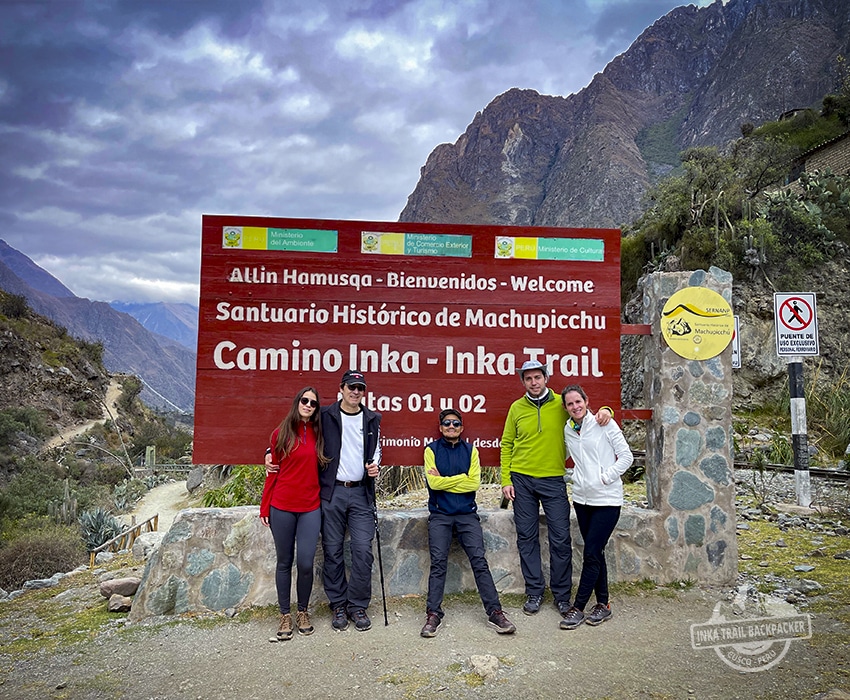
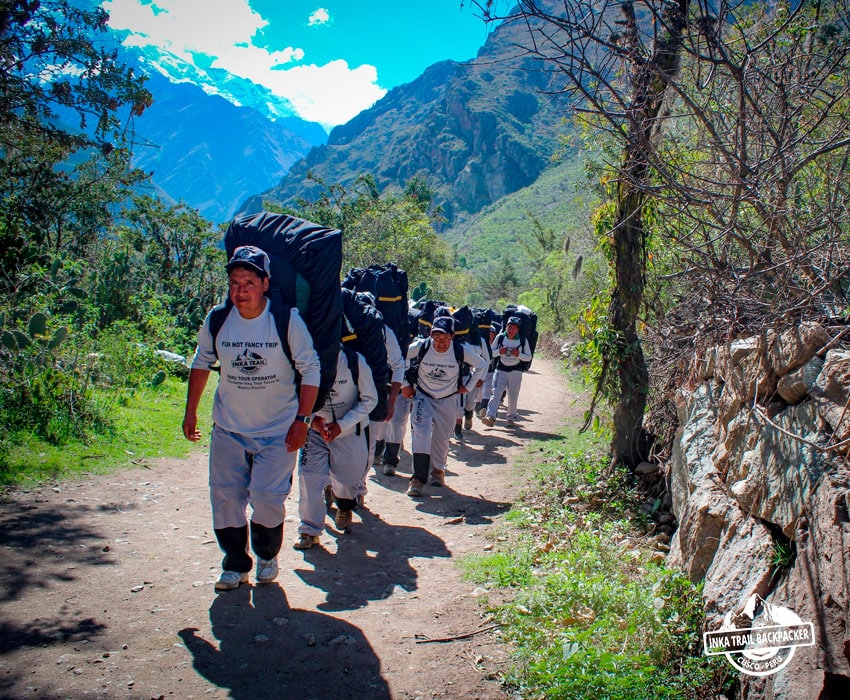
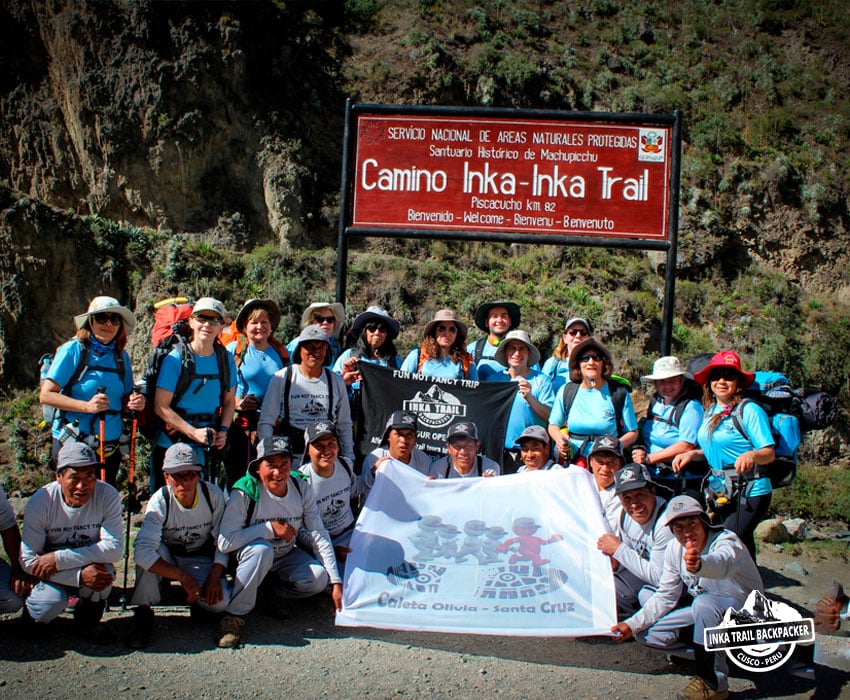
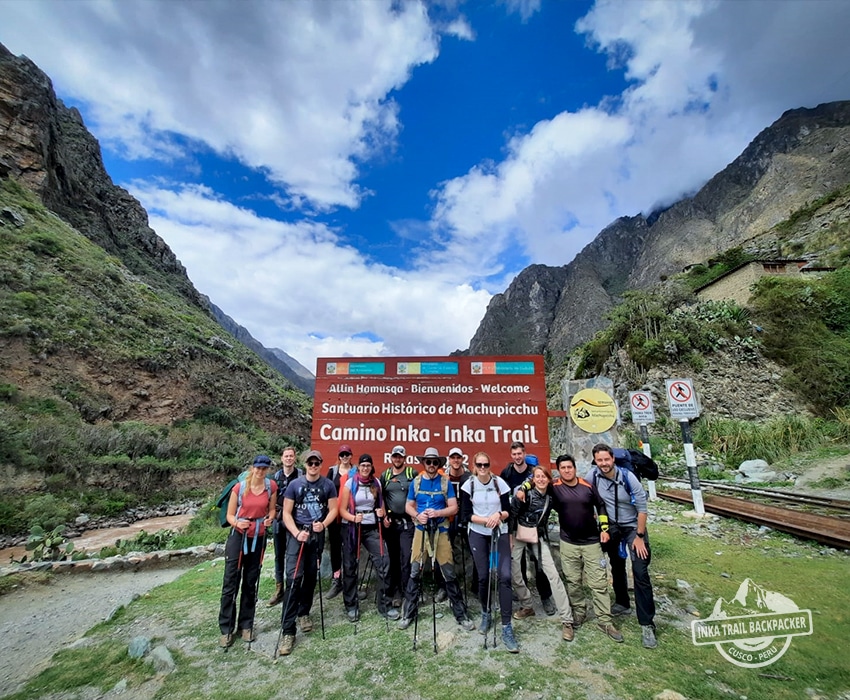
After an early wake up between 5:00 and 6:00 a.m. for a hearty breakfast, we will start a steep ascent towards the highest pass of the trail, Abra de Huarmihuañusca, or “Dead Woman’s Pass”, at (4,200m/13,779ft). En route, we will be able to see hummingbirds and other wildlife. We will also have time to appreciate an incredible variety of native plants and trees such as the Polilepys or Q’ueuña, which grow in the astonishing cloud forest at (3,650m/11,972ft) above sea level. When we reach the top of the mountain pass, you will a true sense of achievement—many consider this the most rewarding moment of the trek. After a break at the top of the pass, we will begin the descent to the lunch stop, which is located at Pacamayu, at (3,550m/11,646ft). After lunch is another steep climb to the Runkuraqay Pass, at (4,000m/13,123ft). We will arrive at our campsite by 5:00 or 5:30 p.m. This will be a very long day, but filled with spectacular views. The temperature at this campsite will be around 6°C / 43°F at night.

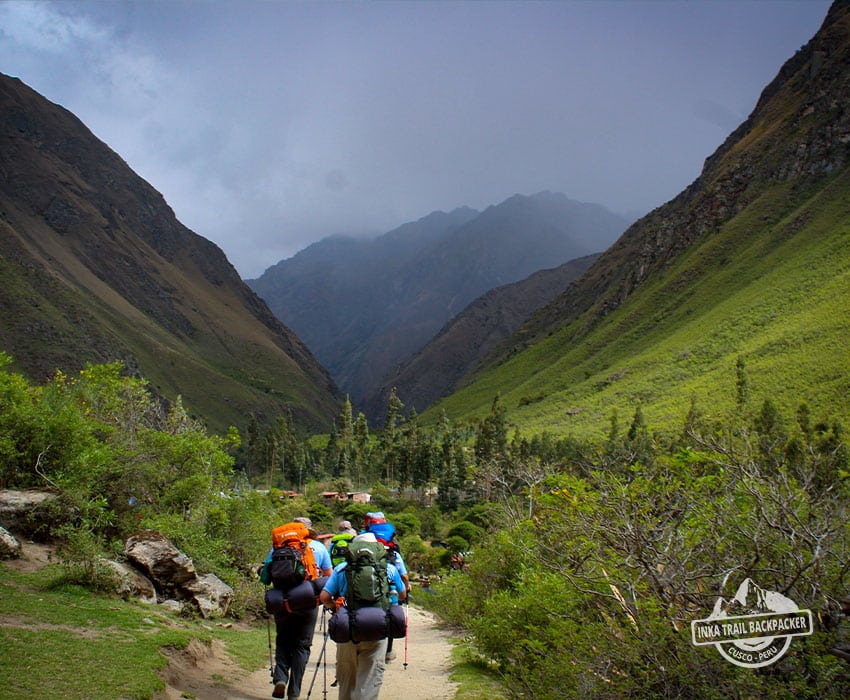
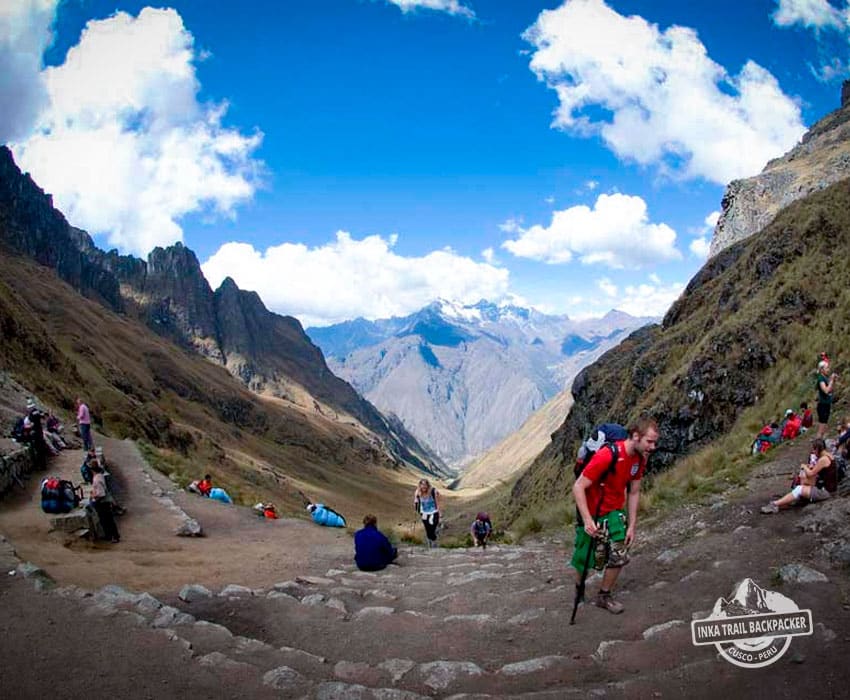
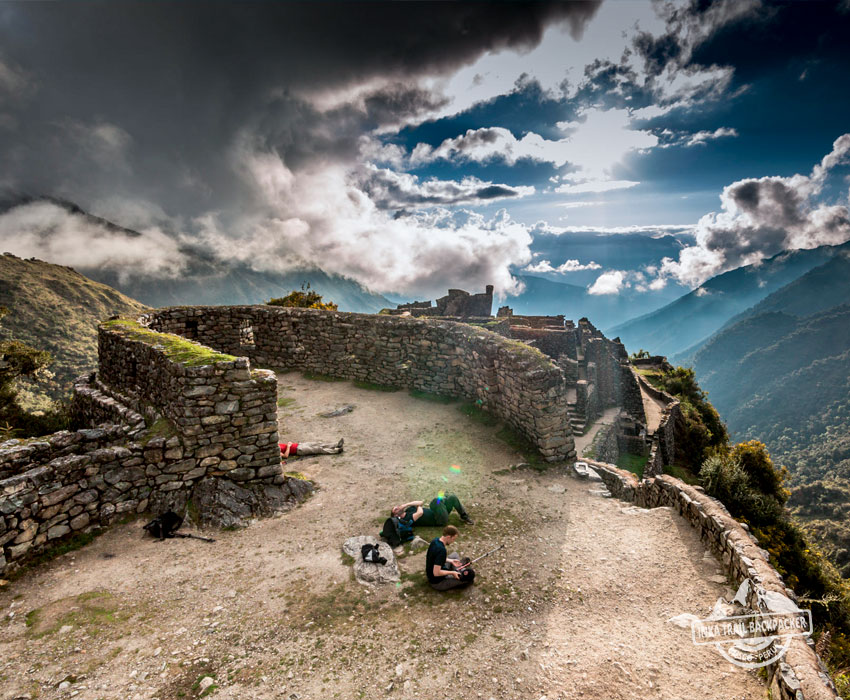
We will wake up for breakfast at 6:00 a.m. and start the day with a gentle climb to visit the archaeological site of Phuyupatamarca, which means “the town in the clouds”. This will be the third highest point on the trail, at an elevation of 3,680m/12,073ft. The views of the mountains, canyons, and surrounding areas are spectacular. The ruins of Phuyupatamarca is located a few minutes walk from the third pass. After visiting this site, we will continue walking onwards through the cloud forest to the impressive agricultural Inca site of Intipata before reaching our final campsite, Wiñay Wayna, at 2,680m/8,792ft. Day 3 requires approximately only 5 hours of walking to reach Wiñay Wayna, which means “forever young”. An Inca site of the same name is located a short distance from this campsite. Even if you are tired after Day 3, don’t miss out on visiting the most impressive site on the trail.

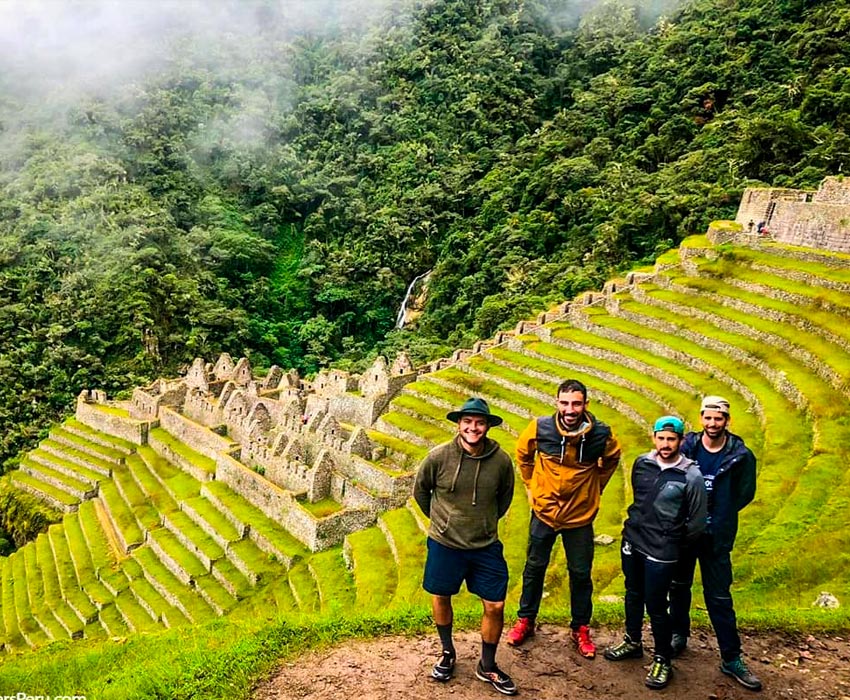
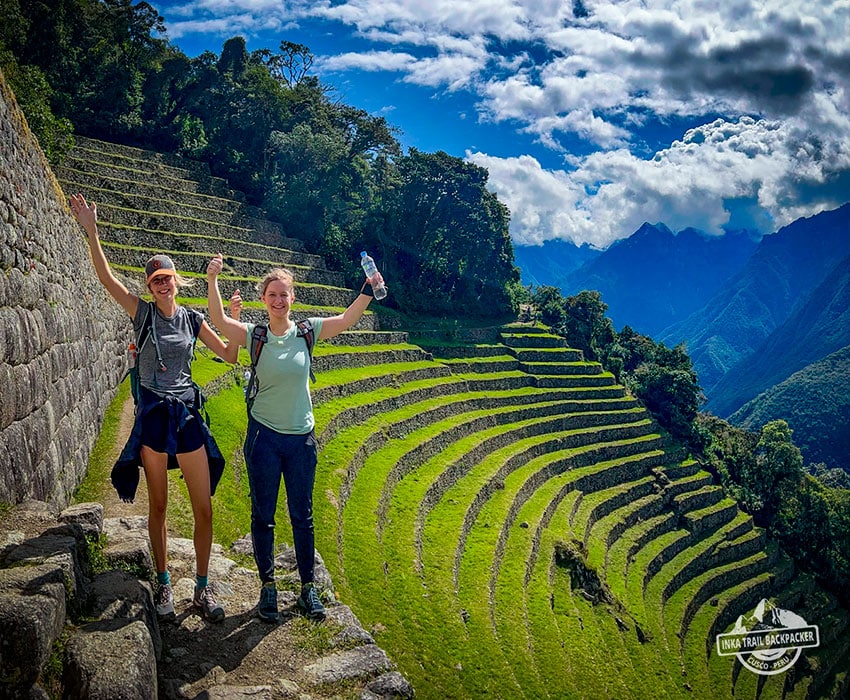

On our final day, we will wake up between 3:00 and 3:30 am in the morning, pack our bags, and set out for our final day of trekking to Peru’s most iconic landmark! Since our porters will leave us after Wiñay Wayna to descend by a different trail to the train station, we will take our breakfast to go. After a ten-minute walk, we will arrive at the Inca Trail’s final checkpoint, where we will queue with all of the other trekkers to wait for the park rangers to open the last section of the trail at 5:30 am. Our early wake-up time will ensure both that we get a forward spot in the line at the checkpoint and that our porters are able to catch the 5:30 am train.
Once the trail opens, we will hike in the early morning darkness for approximately ninety minutes until we arrive at Inti Punku, the “Sun Gate” (2730m/8792ft), just as the sun’s first rays appear over the rooftops at Machu Picchu—this first dramatic view of the sunrise over Machu Picchu will make for a memory you will never forget!
After soaking in the view, we will walk down the final part of the trail and approach the ancient city, where we will be able to celebrate our accomplishment and pose for photos together before the steep peaks and mist-filled ruins of this amazing place!
We will descend to the main entrance, where we can leave our backpacks, use the restroom, and enjoy a quick coffee. After our break, we will re-enter Machupicchu for a walking tour of the mysterious city, According to the new Inca Trail regulations, we will re-enter Machu Picchu using Machu Picchu and circuit 3 Â
Once inside the Inca citadel, you will enjoy a guided tour of approximately two hours, exploring the most relevant sectors of this incredible ancient site. You’ll see houses, temples, terraces, and crop fields, among other features. The ingenuity of the Incas in terms of engineering work, which was far ahead of its time, remains a mystery in many aspects.
After your tour, you can choose to ascend Huayna Picchu Mountain (2,720 m / 8,924 ft) or Machu Picchu Mountain (3,000 m / 9,843 ft) These tours will take you approximately one and a half and three hours, respectively, for both ascent and descent (tickets must be booked in advance).
Ensure you return to Aguas Calientes for lunch before boarding your train to Ollantaytambo, which departs at around 18:20 (subject to availability). Our private transportation will collect you from the next station and drive you back to your hotel in Cusco at around 10 pm.

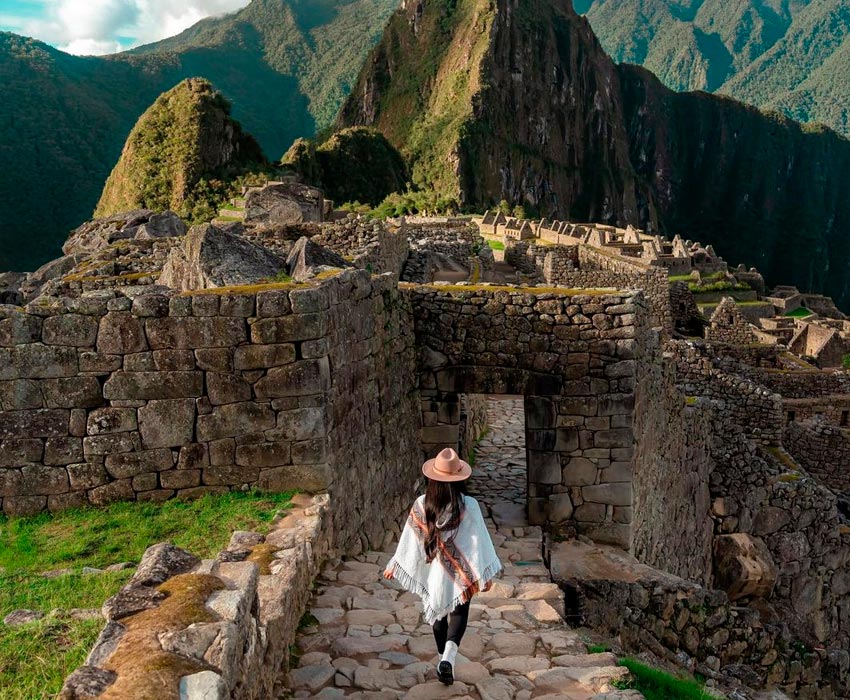
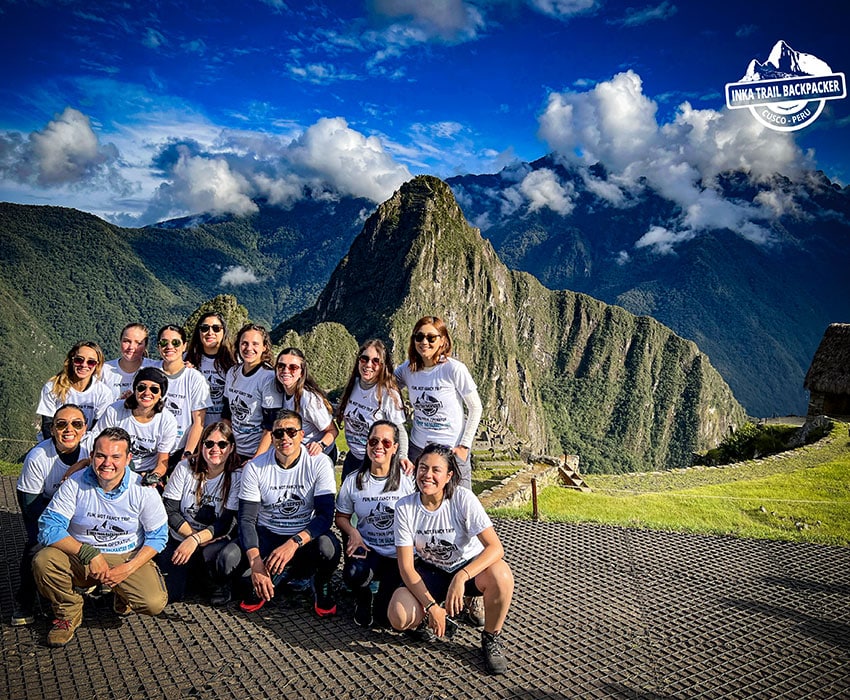
Price to the Classic Inca Trail to Machu Picchu with Personal Porter:
Price: $ 810.00 USD per person

Additional Upgrades for Classic Inca Trail to Machu Picchu:
The schedule for the return train at the end of the Tour/Trek is the Expedition Train, departing at 6:20 p.m. or 7:00 p.m., depending on availability.
If you prefer an earlier train for the return journey, we can arrange it for an additional cost of $35 per person. The available times are 2:55 p.m. or 4:35 p.m. We also offer the option to book the Vistadome train at 3:40 p.m. for an additional cost of $65 per person. Please let us know in advance which train schedule you prefer. Please note that none of the reserved trains go directly to Cusco; they only go to the Ollantaytambo or Poroy stations. In any case, we will ensure that transportation will be arranged to pick you up and bring you back to Cusco.
Can I change my return train ticket to an earlier one at the Aguas Calientes station?
Yes, you can make this change in person at the Aguas Calientes train station. However, they will ask you to pay an additional fee for changing the ticket, and the change will be subject to availability of space and train schedules.
How long does the return trip to Cusco take?
The return journey to Cusco takes approximately 3 hours. First, you will board a train in Aguas Calientes, which will take you to the Ollantaytambo train station for 1 hour and 30 minutes. Then, a transfer from our office will be waiting for you at the train station exit with a sign bearing your name to drive you back to Cusco in a car or van for approximately 1 hour and 30 minutes. Finally, they will drop you off at your hotel or hostel. You will receive your train tickets once your Machu Picchu tour has concluded.
Rental Items
Sleeping bags $20 per person
Walking poles (sticks) $15 per person
FOR YOUR DUFFEL:
Porters will carry up to 6 kg of your personal items. This must include your sleeping bag and air matt (if you bring/rent one). From us these two items weigh 3.5 kg.
TOILETRIES:
INSIDE YOUR DAYPACKS:
Daypacks can be any size for hiking, but we always recommend the smaller, the better. Inside Machu Picchu, no bag larger than 25L will be allowed in. If larger, you will need to store outside citadel gates.
Inka Trail Backpacker has been a Licensed Inca Trail Tour Operator since 2014. All companies managing the Inca Trail must be certified and have an Inca Trail operators license. This license is issued annually each December and Inka Trail Backpacker is licensed through the year of 2020.
Our license as an Official Travel Agency is under the name Inka Trail Backpacker E.I.R.L Our License as an Inca Trail Operator is under the name of INKA TRAIL BACKPACKER E.I.R.L We also work with partner company licenses such as INTI SUN TREK E.I.R.L and GRUPO CAMINOS DEL PERU E.I.R.L. Getting the permit for the Inca Trail from the government is a complicated and stringent process for the protection of tourists so in order to guarantee an Inca Trail Permit for all the tourists that have decided to book their adventure with us, we are registered to book using any of the above-mentioned company licenses. We are all registered on the official Government website: www.machupicchu.gob.pe.
At Inka Trail Backpacker, we deeply value and respect the work of our porters, who are essential to the success of our expeditions. We take pride in strictly adhering to the Porter Worker Law No. 31624, implemented in 2022, which establishes clear and fair guidelines to protect the rights and well-being of all porters working along the Inca Trail network.
This law was created to ensure that porters receive dignified treatment, fair wages, and safe working conditions. At Inka Trail Backpacker, we are committed to the care of our porters, meeting and exceeding the standards set by the law. We make sure they work under fair and humane conditions, with the appropriate equipment, and within the weight and work hour limits established by the regulations.
We recognize that the effort and dedication of our porters are vital to providing the best experience for our clients. That’s why, beyond what the law requires, Inka Trail Backpacker takes additional steps to ensure their well-being, offering continuous support and fostering a respectful and supportive work environment.
At Inka Trail Backpacker, we are firmly committed to sustainability and ecological responsibility in all of our tours. We strive to minimize our environmental impact by adopting eco-friendly practices and promoting sustainable tourism. Our goal is to preserve the natural beauty and cultural heritage of the regions we visit, ensuring that future generations can continue to enjoy these incredible landscapes.
We take concrete actions to reduce waste, use biodegradable products, and follow responsible waste management practices. Additionally, we educate our clients about the importance of environmental conservation and encourage them to contribute to the protection of the ecosystems we explore.
Travel with Like-Minded Adventurers:
Our Work with Local Communities:
At Inka Trail Backpacker, we like to think we do trekking a little differently than our competitors. We stand by our customers and guarantee that we meet 100% of our departure dates on our treks even if you are a solo traveler.
Our office is located at 392 Calle Triunfo (the street is also called Sunturwasi), inside the Centro Artesenal Arte Inka Building, which is on the corner across the street from the Museo Arzobispal and the Twelve-Angled Stone, by a small fountain. We are on the second floor, in Suite 209.
At Inka Trail Backpacker, providing a personal experience and ensuring you are thoroughly prepared for your trek is very important to us. Before you depart on the Inca Trail trek, you will receive a briefing in our office. At the briefing, you will get to meet our staff, receive maps and a detailed description of each day of your tour, be given duffel bags if you have hired a porter, and have the opportunity to ask questions.
When you pay with a credit card or PayPal, there is a 6% service charge added to the total cost of your tour. However, there is no service charge if you pay with cash; for this reason, the total cost of the tour will be higher when you pay with a credit card.
Our team of guides are all local to the Cusco area and speak both Spanish and English fluently. Many of them also speak Quechua (the native language of Peru). With degrees in tourism and with two years minimum of experience under their belts, they are full of energy, information about the native flora and fauna, and the Inca sites, with a vast knowledge of ready sourced stories and legends told by the Andean people.
The maximum size of our Inca Trail 4 day group service is 16 people. For groups of over 8 people we also employ an assistant guide to help out (the assistant guide is a fully qualified guide but may lack some of the experience of the main guide or still need to improve his/her English skills.
The Classic Inca Trail Machu Picchu is a 42 km (24.4 mile) hike through the Andes in the Cusco region. The maximum altitude reached is 4,217m/13,907ft. On the second day of the trek, we climb two mountains. The Trail is a fairly difficult trek; you should be well prepared and healthy prior to starting it. You have to be moderately fit and exercise regularly.
In preparation, try walking 15kms per day or go to a fitness club in the months leading up to the trek. It is also important to be well acclimatised to the altitude. Try to spend at least two or three days in Cusco (3350m/11,047ft) prior to starting the Classic Inca Trail Machu Picchu.
If you plan to renew or change your name on your passport between making your trek booking and starting your trek, you can book your trek or tour with your current passport number or name, but you must send us a copy of your old passport and a copy of your new passport when you have them. We can then make the change with the government before you arrive. The extra cost to make the change is US$25 per person. (This will cover the change in number or name for your Inca Trail Permit, Machu Picchu Entrance, and train.)
If you do not advise us of the change or do not want to pay the fee, bring the original of both passports (the old and new one). You can enter Peru with your new passport but you must show the government authorities your old passport in order to enter the Inca Trail, Machu Picchu or train. If you cannot do so, you will not be allowed to start your trek by the government officials. All names and numbers must match!!
Toilets have improved a lot in the last couple of years and all of the larger campsites have flushable toilets and running water. Overall, they are kept pretty clean. If you do need to use the toilet between campsites, then please defecate away from the trail and water supplies; you can dig a hole, or cover your feces with a rock, and take the paper with you in a bag to deposit in one of the several bins along the way. There are hot shower facilities in Wiñay Wayna on Day 3, although they are usually not very clean.
Important: As a sustainable tourism operator that takes care of our porters we do NOT take portable toilets.
Tips for porters, cooks and guides are always welcome. The porters are also very grateful for small gifts, such as clothing and school equipment for their children. A normal amount is S/60-80 for each porter and S/120 for the chef. The group will pool money for the tip, this is not an individual amount.
If Inka Trail Backpacker fails to confirm the reservation, your payment will be refunded in full.
A participant must declare if he/she has any sickness or medical disorder and must bring his/her own medication. We recommend that you meet with a doctor before you book the trek if you have questionable health.
Always fresh and featuring organic ingredients, the food on the Inca Trail is always something to look forward to. There is always plenty to eat and lots of options including vegetables, meat, chicken, fish and other sources of protein and carbohydrates. On our tours, everyone sits down to eat together and enjoy each other’s company.
We offer standard meals as well as a vegetarian meal option. Just let us know if you want vegetarian meals when you book your trek.
Vegetarian meals have no red meat, chicken or fish. We will assume that eggs and dairy are OK. We are unable to cater specifically for vegans as it is too complicated for our cooks (remember they are cooking in a tent). Most of our main meals in the evening are served as a buffet service so you can always leave out what you don’t like. If there is a particular food that you don’t like (i.e. tomatoes, onions, mushrooms, etc) we will ask the cook to do his best to leave them out of the dish, but we cannot guarantee this. We can also cater to lactose-intolerant and gluten free diets (mild reactions only, no life threatening allergies accepted- see below). We reserve the right not to accept a trek booking based upon dietary requirements, this may be because we already have several people booked requiring special meals and don’t want to further inconvenience our cook. Thanks for your understanding.
Standard (no dietary requirements, will eat everything)
Vegetarian
No red meat (chicken & fish ok)
No fish (red meat and chicken ok)
Lactose-free (mild reactions only)
Gluten free (mild reactions only)
Unfortunately, we don’t offer a combination of the above i.e we don’t accept vegetarian AND gluten-free.
You can leave any of your belongings that you do not want to bring on the trek at your hotel or hostel you were previously staying in. These hostels/hotels usually have a secure, locked room where you can store your belongings. If you do not trust your hostel, we would be more than happy to securely store your belongings for you.
We require everyone to be in Cusco for at least 2 nights prior to starting the trek, although 3 nights is even better. You must pay your trek balance at least 2 days before trek departure. For example if your trek departs on a Monday you must come to our office before 7.30 pm on Saturday to pay the trek balance. This ensures that everyone in the group is well acclimatized to the high altitude before starting the trek.
It is very important to be well acclimatized before exerting yourself on a trek. This is why we require everyone to be in Cusco for a minimum of 2 days prior to regular treks like the Inca Trail. However, if you are doing one of our longer treks like the 6 day Combined Salkantay/Inca Trail Trek, you will need at least 4 days to acclimatize because these treks occur at much higher altitudes than Cusco. You can use this time spent acclimatizing to visit the city of Cusco, nearby Inca ruins, and the Sacred Valley of the Incas.
Wiñay Wayna is the campsite closest to Machu Picchu, so it is everybody’s favourite campsite. Wiñay Wayna is about a 2 hour trek to Machu Picchu so it allows the group to arrive at Machu Picchu very early in the morning. However there is not enough space at Wiñay Wayna for all the Inca Trail groups. The next nearest campsite is Phuyupatamarca which is a 5 hour trek to Machu Picchu. When we buy the trek permits for the group we are allocated the campsites by the government. We highly recommend that you book your Inca Trail permit on a day with more than 160 available spaces. Otherwise, you may not be able to camp in Wiñay Wayna campsite.
No, sneakers are not recommended for the Inca Trail! The terrain is very steep, with loose gravel, puddles, mud, and other obstacles. You must have sturdy, waterproof footwear designed for this type of terrain, with good traction and ankle support. Be sure to break in your hiking boots before your trek! Wear them on several shorter walks or hikes before your trip, so that your feet can get used to them.
If you do not have hiking boots, or they are too bulky for your suitcase, you can rent them in Cusco for under one hundred soles.
Ollantaytambo is the best place to stay other than Cusco. By staying in Ollantaytambo, you actually get a little more sleep because we will be picking you up about 1.5 hours after the Cusco pick up time. However, please keep in mind that the pre-trip briefing can only be done in Cusco.
Our sleeping bags are rated for temperatures as low as -10°C, but are more suitable for temperatures of about -5°C. Since you won’t find temperatures as low as this on the trek, we rate them as very warm and cozy! We charge US$20 per person for the whole trek.
Yes, all our tour guides take an oxygen bottle with them along the trail and will provide oxygen as needed.
On the morning of the trek departure, we will pick you up from inside your hotel in Cusco (don’t wait outside in the street) and drop you off either in the Plaza de Regocijos ( next to the main square) or Plaza San Francisco (two blocks from the main square) upon your return to Cusco. You won’t be dropped off directly at your hotel/hostels.
It helps us if you try to stay in a hotel/hostal that is within a few blocks of the Plaza de Armas (Main Square). If your hotel/hostal is far away from the main square we will ask you to come to our offices with the exact location and name of your accommodation. If you are not staying in the city center, we may not be able to pick you up from your hotel. You must take a taxi to the center.Â
The guide will come into your hotel and ask for you at reception. Because the centre of Cusco is full of small cobblestone streets, our larger bus/van is not permitted to enter certain zones in the city centre, so you will then have to walk a short distance to where the bus/van will be waiting for you. Traffic regulations prohibit large buses/van from entering the main square but usually after 10pm we don´t have a problem and will be able to drop you off in the main square upon your return. You can then take a taxi back to your hotel (between US$2 to US$4 for a taxi).
If we have to drop you off in Plaza San Francisco, you may be a bit disoriented (some people may need to be woken up!!) but we recommend that you ask for directions to the Plaza de Armas and our guide or driver will be happy to help. It’s only two blocks away, but usually it’ll be quite late at night so it is best to walk together as a group back to the Plaza before taking a taxi or walking back to your hotel.
Your entrance time to Machu Picchu will depend on when you book your trek. As of July 1, 2017, there are two possible entry times to the site: 6:00 am to 12:00 pm, or 12:00 pm to 5:00 pm. Your ticket will grant you entry for either the morning or the afternoon—not both. The morning entry is significantly more popular and quickly sells out—unless you book your trek two to three months in advance, we cannot guarantee a morning entry.
If you book far enough in advance to secure a morning entry, you will start to hike up to Machu Picchu at 4:30am, arriving at the site by about 6:00 am—just in time for the sunrise!
We require a minimum group size of just four people. During the last few years, Inka trail Backpacker has always managed to meet the minimum group size for ALL of our departure dates and have never had to cancel any group departures due to group size.
If in the unlikely event that we do not reach the minimum required number of persons we reserve the right to combine our clients with another trekking company of similar cost.
Before traveling to Peru, you should consult your doctor. Routine vaccines, Hepatitis A, and typhoid vaccines are recommended for most travelers by the CDC. Some travelers may also need vaccines for Hepatitis B, rabies, and yellow fever. Women who are pregnant or may become pregnant should also be advised that the Zika virus is present in Peru.
Malaria pills are not necessary for these treks.
The rainy season in Cusco is generally from November to April, when there are near-daily showers and the ground—especially in trekking areas—is wet and muddy. However, there are occasional showers throughout the rest of the year; you should always pack a rain jacket, regardless of when you plan to visit. For treks, a rain poncho is highly recommended—since you will be walking through rain for potentially several hours without shelter, a poncho will be much more effective at keeping all of your belongings and your base layers warm and dry. Waterproof shoes are also strongly recommended.
In the event of illness or injury, we will offer all of the support and care we are able; however, you should carry any medications you expect to need with you (ask your doctor for specific recommendations or prescriptions for altitude sickness, traveler´s diarrhea , colds and sore throats, and pain or inflammation). If you are not capable of completing the trek, we will transport you back to Cusco, where you can seek medical treatment. However, the cost of this transportation is not included in your tour and you will be expected to pay the additional expense—for this reason, we highly recommend travel insurance for your trek.
Yes, in all of the hostels that we book for you, you will have a private room and bathroom.
Although not required, walking poles are recommended for any trekkers worried about joint stress or balance. They also are quite helpful in providing stability and leverage on especially steep climbs and descents. If you do not have poles or are unsure how to use them, we are able to rent them to you and provide instruction.
As of July 1, 2017, you must have your original passport to enter Machu Picchu. You also need to have your entrance ticket, which your guide will give to you at the appropriate time. The passport that you bring to Machu Picchu must be the same one that you used to book your tour and entrance; if you change or renew your passport between booking and your trip, please be sure to bring the originals of both.
If you are traveling alone and are willing to share a tent with another participant of the same genre, then there is no additional cost. If, however, you would prefer your own tent, there is an additional supplement of US$40
Photos from our travellers
This trek features four days of hiking on the famous Inca Trail and one night in a hostel in Aguas Calientes. This option will allow you to view Machu...
5 Days / 4 Nights
US$950
This is the classic 4 day / 3 night Inca Trail Trek with the added bonus of an extra night in Aguas Calientes. This extra time will allow you can rela...
4 Days / 3 Nights
US$750
This is the fastest version of the classic 4-day Inca Trail, on this tour you will visit Machu Picchu and return to Cusco in the evening of the third...
3 Days / 2 Nights
US$750
The short Inca Trail trek to Machu Picchu is not very challenging, which makes it perfect for families with children and travelers on a tight time sch...
2 Days / 1 Nights
US$520
The Inca Trail is arguably the most famous and beautiful hike in the world. The Inca Trail to Machu Picchu is one of the most impressive examples of t...
4 Days / 3 Nights
US$810
Classic Inca Trail Trek Economic Tour 4 days / 3 nights. This package is the classic 4 Day / 3 Night Inca Trail Trek Door-to-Door Service, specially...
4 Days / 3 Nights
US$710